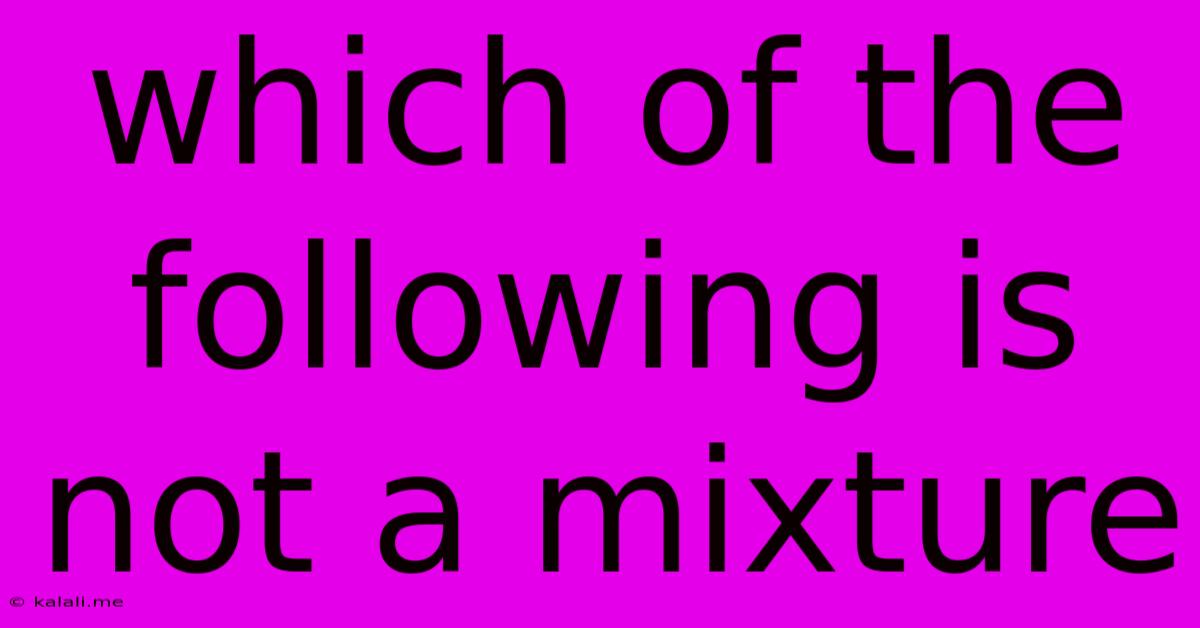Which Of The Following Is Not A Mixture
Kalali
Jun 16, 2025 · 3 min read

Table of Contents
Which of the Following is Not a Mixture? Understanding Pure Substances and Mixtures
This article will explore the difference between mixtures and pure substances, helping you understand why some substances are considered mixtures and others are not. We'll delve into the characteristics of each and provide clear examples to solidify your understanding. This will be particularly helpful if you're studying chemistry or simply curious about the composition of matter.
What is a Mixture?
A mixture is a substance comprising two or more components not chemically bonded. A key characteristic is that the components retain their individual chemical properties. Mixtures can be separated into their individual components through physical methods, such as filtration, distillation, evaporation, or chromatography. Mixtures are further categorized into homogeneous and heterogeneous mixtures.
-
Homogeneous Mixtures: These mixtures have a uniform composition throughout. For example, saltwater, air, and sugar dissolved in water are all homogeneous mixtures. You can't visually distinguish the individual components.
-
Heterogeneous Mixtures: These mixtures have a non-uniform composition, meaning the components are visibly distinct. Examples include sand and water, oil and water, and a salad. You can easily see the separate components.
What is a Pure Substance?
A pure substance is a form of matter that has a constant composition (it's made up of only one type of atom or molecule) and properties throughout the sample. Pure substances cannot be separated into simpler substances by physical methods. They have a fixed melting point and boiling point. Pure substances are either elements or compounds.
-
Elements: These are substances made up of only one type of atom. Examples include oxygen (O), gold (Au), and iron (Fe). They are listed on the periodic table.
-
Compounds: These are substances made up of two or more different elements chemically bonded together in a fixed ratio. Examples include water (H₂O), carbon dioxide (CO₂), and sodium chloride (NaCl – table salt). Their properties differ from those of their constituent elements.
Identifying Non-Mixtures: Examples
Now, let's address the core question: which of the following is not a mixture? To answer this, you need a list of options. However, we can provide examples of substances that are not mixtures because they are pure substances:
-
Pure Water (H₂O): Although water can contain impurities, pure water is a compound, a chemical combination of hydrogen and oxygen atoms in a fixed ratio.
-
Pure Gold (Au): Gold, in its elemental form, consists only of gold atoms.
-
Pure Table Salt (NaCl): While table salt is often mixed with anti-caking agents, pure sodium chloride is a compound, not a mixture.
-
Pure Oxygen (O₂): Oxygen gas in its pure form is an element consisting solely of oxygen molecules.
In Conclusion
Determining whether a substance is a mixture or a pure substance relies on understanding its composition and the ability to separate its components using only physical methods. If a substance cannot be separated into simpler substances by physical means, it's a pure substance (either an element or a compound). If it can, then it’s a mixture. This understanding is fundamental to chemistry and various scientific fields. Remember to consider the properties of each component to accurately classify any given substance.
Latest Posts
Latest Posts
-
Which Of The Following Best Describes A Body In Equilibrium
Jun 16, 2025
-
50 Of What Number Is 80
Jun 16, 2025
-
What Is The Si Unit Of Displacement
Jun 16, 2025
-
Lcm Of 6 4 And 10
Jun 16, 2025
-
Reactive Power Formula In 3 Phase
Jun 16, 2025
Related Post
Thank you for visiting our website which covers about Which Of The Following Is Not A Mixture . We hope the information provided has been useful to you. Feel free to contact us if you have any questions or need further assistance. See you next time and don't miss to bookmark.